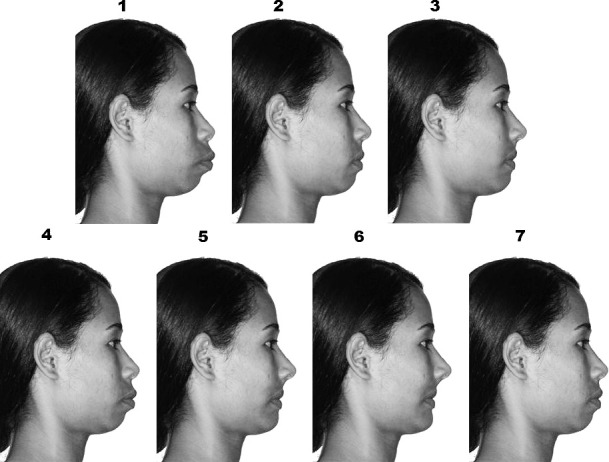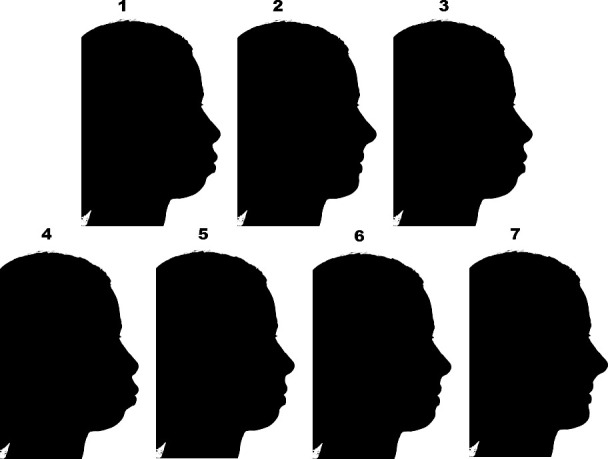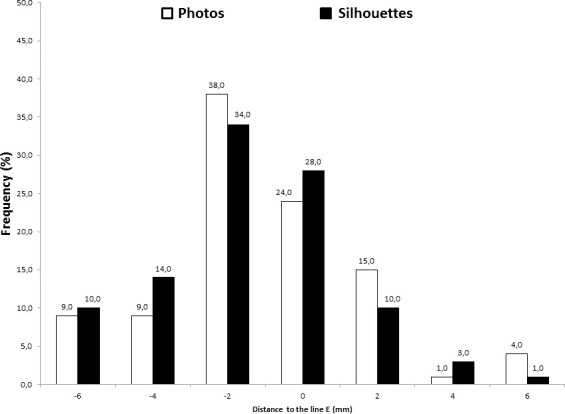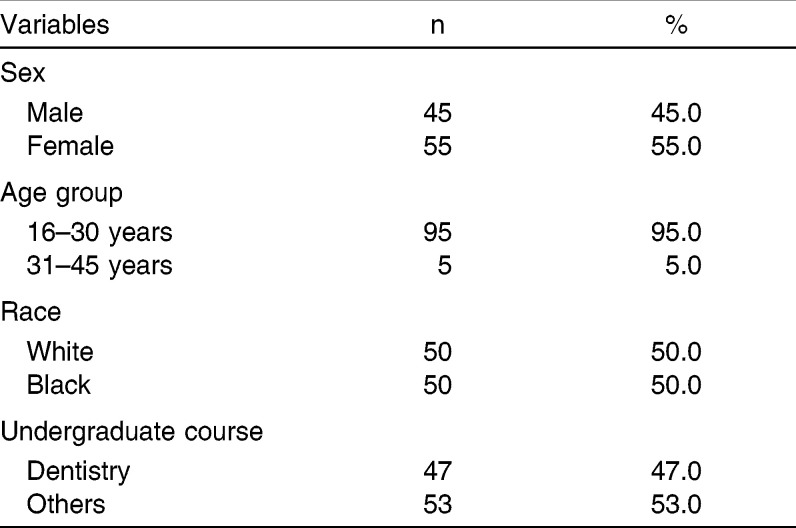Abstract
Objective:
To determine whether photos or silhouettes are adequate methods for evaluating the esthetic profiles of black subjects and whether black and white evaluators have different preferences for esthetic profiles.
Materials and Methods:
One photographic record of the profile of a black female patient with accentuated dental bimaxillary dentoalveolar protrusion was randomly selected. The image of the patient's profile was altered to produce a series of seven photos and seven silhouettes (a total of 14 images) with different lip positions but uniform distances in relation to the esthetic plane created by Ricketts (line E). Fifty black and 50 white lay evaluators were invited to enumerate the photos and silhouettes, produced according to the lip position, in the order in which they considered most esthetically pleasing.
Results:
The number of preferences found to be within the esthetic norm was slightly higher among the photographs than among the silhouettes; the esthetic profile with a deviation of −2 mm from line E was elected as the most attractive, and the esthetic pattern with a deviation of +6 mm from the normal line E was considered the least attractive. There were no statistically significant differences between the preferences related to the variables race, sex, and educational background.
Conclusions:
The esthetic attractiveness of the facial profiles of black subjects in photos and silhouettes was evaluated in a similar manner among black and white evaluators. Among both black and white evaluators, the greatest preference was for the slightly concave profile, which was within the limit considered standard.
Keywords: Perception, Profile, Esthetic
INTRODUCTION
Appearance is a determinant factor in social integration and self-esteem. In view of this, facial and dental anomalies that affect appearance may have a great influence on a person's psychological state.1,2 Nowadays, in addition to good dental intercuspation, patients and orthodontists seek to obtain a harmonious and pleasant facial profile.3 The position of the lip is an essential element when one intends to reposition the teeth in the anterior or posterior direction, and this factor is of the utmost importance in obtaining a balanced profile.4
Various studies have reported that the structure of the soft tissue and bone/dental profile in black individuals is more protrusive in comparison with the pattern for white individuals. In view of this, it is common for black patients to seek orthodontic treatment to reduce labial protrusion by extracting the four first premolars.5
Some persons who complain about unpleasant facial esthetics and consult orthodontists to regain the balance of their facial profile exhibit biprotrusion, a condition in which maxillary and mandibular anterior teeth are protruded, creating a convex profile and making it difficult to close the lips.
An ideal and pleasant soft tissue esthetic profile, in spite of being subjective and personal, is of great importance in orthodontic treatments. Various studies have sought to determine the ideal measurements.6–9 Among the angles and lines considered patterns, the esthetic plane created by Ricketts (line E - soft pogonion - the nose tip) is widely used because of its easy application and because the large number of studies that have been conducted provide much data for comparison.4
At the present time, however, greater attention has been paid to facial analysis that is detached from linear and angular measurements, which have been shown to be rigid and immutable. For esthetic analysis, some researchers defend the use of photographs, affirming that an esthetic and pleasing face is a set of diverse factors. On the other hand, there are those who believe the use of silhouettes is a method that eliminates distractions so that one may focus on the patient's profile. With the intention of evaluating whether there is a difference between the two methods of facial analysis, the authors of the present study sought to determine whether photos or silhouettes are adequate methods for evaluating the esthetic profile of black subjects with different degrees of labial protrusion and retrusion, and whether black and white evaluators have different preferences for certain esthetic profiles.
MATERIALS AND METHODS
In order to conduct this study, we used the image of the profile of a black woman with accentuated dental biprotrusion who received orthodontic treatment at the Orthodontic Clinic of the State University of Southwest Bahia (Universidade Estadual do Sudoeste da Bahia - UESB). The inclusion criteria for selecting the photograph used was age range of 14 to 20 years; black ethnicity; no excessive visible hair, makeup, or facial or surrounding ornamentation; and no hat, spectacles, or other accessories covering part of the face. The image of the initial profile was digitally altered with an image-manipulation program. The patient's consent to use the photograph and teleradiograph was obtained by means of signature of a term of free and informed consent to undergo orthodontic treatment, stated on the respective patients' clinical record charts.
The pretreatment photographic image was manipulated to produce different lip positions with alterations of 2 mm. All the alterations were limited to the anteroposterior dimension, and there were no alterations in the vertical dimension. The structures manipulated were the soft tissues between the subnasal points and mentolabial sulcus. The initial photographic image was changed in relation to Ricketts' line E, producing positions of −4, −2, 0, +2 (standard), +4, +6, and +8 mm in the bottom lip. These images were then changed to produce the images of the silhouettes by adjusting the brightness and color, producing an image in two tones. Thus, seven modified photos and seven corresponding images of the silhouettes were produced, resulting in 14 images.
The seven modified photos were placed in a set in a single slide, so that there were seven photos per slide (10 × 6 cm), which were numbered according to the labial position that would be considered most esthetic. The process was repeated to evaluate the reliability of the evaluation. The slides presented a sequence of the individualized modified photos so that the evaluator could stipulate a score from 0 to 10 (visual analog scale). The same was done with the silhouettes, producing another slide containing seven silhouettes and then seven more slides containing one silhouette each; these were evaluated in the same way as the photographs. The images, mounted in a specific program (Microsoft Office PowerPoint 2010, Mountain View, Calif), were presented to the evaluators on a portable computer. The photos and silhouettes were randomly arranged (Figures 1 and 2). To determine the number of persons to be researched, a sample calculation was made that yielded a target population of 100 persons.
Figure 1.

Models of photos of the same person with different lip positions.
Figure 2.

Models of silhouettes of the same person with different lip positions.
The evaluators consisted of 50 black and 50 white descendants who were students at the State University of Southwest Bahia in different undergraduate periods. Each examiner indicated his or her sex, race, undergraduate period, and age on the data collection form. Each evaluator received an original research number so that he or she could not be identified during data analysis. An information sheet describing the research was handed to each evaluator, and at the beginning of the presentation, evaluators received an explanation about the study and were shown examples of the images they were going to evaluate. They were told the time considered necessary to conclude classification but were instructed not to go back to slides they had already evaluated.
Statistical Analysis
The frequencies of the responses given by the evaluators were compared according to sex, race, and undergraduate course by means of the Fisher exact test. To evaluate the agreement between the methods of evaluating the esthetic profile, the gross agreement and Kappa index of agreement were calculated. Comparisons between the evaluation scores according to sex, and race were made using the Mann-Whitney test. Differences between the scores for the photographs and silhouettes were tested by the Wilcoxon test. Lin's coefficient of agreement was used as a measure of agreement between the scores of the two methods of evaluating the esthetic profile.
For all statistical analyses, a level of significance of 5% (P < .05) was adopted. The data were analyzed with the statistical software program SPSS 13.0 for Windows (SPSS Inc, version 13, Chicago, Ill) and MedCalc (version 9.1.0.1, 2006, Ostend, Belgium).
RESULTS
Table 1 shows the demographic data of the study participants. Most evaluators were women and in the youngest age group. The distribution was equal for the two racial groups.
Table 1.
Description of the Evaluators
All 100 evaluators reported perceiving differences between the two sets of images of photographs and silhouettes. Figure 3 shows the evaluators' preference for the photographs and silhouettes. The percentage of agreement between the methods was 36%, which could be considered very weak (Kappa = 0.16). For both methods of evaluating the esthetic pattern, the deviation of −2mm from the normal line E was chosen as the best by most evaluators. According to the Fisher exact test, the frequencies did not differ by sex (photographs, P = .202; silhouettes, P = .722), race (photographs, P = .389; silhouettes, P = .246), and undergraduate course (photographs, P = .949; silhouettes, P = .417).
Figure 3.

Evaluators' preference according to the method of evaluating the esthetic profile.
The frequency of evaluators who preferred the photographs within the acceptable esthetic variation was a little higher than it was for the silhouettes (Figure 4). The percentage of agreement between the methods was 75%, which could be considered weak (Kappa = 0.38).According to the Fisher exact test, the frequencies did not differ by sex (photographs, P = .519; silhouettes, P = .175), race (photographs, P = .751; silhouettes, P = 1.000), and undergraduate course (photographs, P = .933; silhouettes, P = .382).
Figure 4.

Evaluators' preference according to the method of evaluating the esthetic profile.
Figure 5 presents the evaluation scores for the different esthetic patterns, according to the method of evaluation. For both methods, the esthetic pattern with a deviation of −2 mm from the normal line E was chosen as the most attractive, whereas the esthetic pattern with a deviation of +6 mm from the normal line E was considered the least attractive. According to the Mann-Whitney test, in all the esthetic patterns and both methods, there was no significant difference in the evaluation scores between the sexes (P > .05) and between the evaluators' graduation courses (P > .05). Regarding race, a statistical difference was found (P = .016) only for the esthetic pattern evaluated by the silhouette with a deviation of −4 mm from line E; the results indicated that white individualss (score = 6.21; SD = 2.15) evaluated this pattern as being more esthetically pleasing than black individuals (score = 5.18; SD = 2.30).
Figure 5.

Evaluation scores according to the method of evaluating the esthetic profile.
Table 2 presents the comparisons and coefficients of agreement for the evaluation scores of the esthetic profiles. Statistical differences could be observed between the methods of photographs and silhouettes in the scores of four of the seven patterns with deviation from the normal line E: −6 mm, 0 mm, +2 mm, and +6 mm. The Lin's coefficient showed low agreement between all the scores of the photographs and those of the silhouette method for evaluating the esthetic profile.
Table 2.
Evaluation Scores According to the Method of Evaluating the Esthetic Profile
DISCUSSION
There has been growing concern about facial esthetics among patients and professionals, and soft tissues have been increasingly emphasized in orthodontic diagnostic methods. Facial harmony is one of the main objectives of orthodontic treatment, because the correct positioning of teeth on the basal bone may alter the profile, including the upper and lower lip positions and nasolabial and labiomental angles. Because of the importance of the facial profile in orthodontic treatment, there is a need to determine the best method for evaluating a more esthetic profile by using photos or silhouettes.
The studies of Kokich et al.10 served as a basis for this study. In those studies, an interval of 2 mm was determined so that evaluators would be capable of detecting differences between dental esthetic alterations.
The two racial groups were distributed in an equitable manner (the same number of white and black evaluators) to provide this study with greater reliability by presupposing that the results were not influenced by the ethnicity of the evaluators. As opposed to the study conducted by Hockley et al.,4 in which only white orthodontists evaluated the profile of black patients.
According to Scott and Johnston,11 when conducting a study on the impact of orthodontic treatments with and without pre-molar extractions, the academic background of the evaluator has significant impact, irrespective of race or treatment, with orthodontists tending to make a significantly better analysis with regard to the most esthetic profiles of black patients.
In the study by Lim et al.,12 it was emphasized that the esthetic evaluation of facial profiles could differ according to the evaluators, their social environment and the period of history in which they lived, particularly when they consider the ethnic characteristics of the subjects; however, there were no significant differences among dentists and laypersons in their perception of esthetic impact.
In the present study, according to the Fisher exact test, there were no statistically significant differences between the evaluators with regard to the variables sex, race, and educational background.
Hwang et al.13 compared the soft tissue profiles of European-American and Korean adults with normal occlusions and balanced facial profiles. They reported that white men had a bottom lip at −4.63 from Ricketts' line E; Koreans had a bottom lip at +0.98 from this same line; and white and Korean women had measurements of −3.98 and +1.40, respectively. This study found that the labial protrusion in white profiles tended to increase over time; moreover, Korean respondents preferred more concave profiles and white respondents preferred more convex profiles. In the same way, in the study conducted by Lim et al.,12 preferences were shown for more concave profiles in Korean adults with normal occlusion.
In the study by Hockley et al.,4 evaluators preferred profiles +1.5 mm forward of Ricketts' line E in photographs of both sexes. In contrast, in silhouettes, the same evaluators preferred profiles +0.25 mm forward of line E for women and −0.1 mm behind line E for men.
In the present study, for both methods of evaluation—photos and silhouettes—the esthetic pattern with a deviation of −2 mm from Ricketts' line E (slightly concave) was selected as the most esthetic by most of the evaluators. The black evaluators also opted for slightly concave profiles, a finding that was confirmed by such studies as the one conducted by Marques et al.,5 in which black lay respondents preferred straighter profiles when they evaluated pre- and post-orthodontic treatment photographs of patients of the same ethnicity who presented biprotrusion; 67% of these evaluators considered this profile to be less pleasing.
Clinically, orthodontists diverge with regard to the use of photographs, silhouettes, and cephalometric tracings for evaluating the esthetics of the facial profile. When observing silhouettes, one can eliminate factors that influence the observer's perception of attractiveness; however, silhouettes do not allow the evaluator to visualize the entire face for a more complete facial analysis. In contrast, by exhibiting more information to the evaluator, photographs allow quantification of changes in the facial esthetic profile. In this study, photographs and silhouettes were used, and no divergences occurred between the two methods, proving their applicability.4
CONCLUSIONS
The slightly concave profile was preferred by the study participants, irrespective of the evaluators' sex, race, and undergraduate course.
Generally speaking, the two methods—photos and silhouettes—show good agreement for the evaluation of attractiveness.
REFERENCES
- 1.Almeida MD, Farias ACR, Bittencourt MAV. Influence of mandibular sagittal position on facial esthetics. Dental Press J Orthod. 2010;15:87–96. [Google Scholar]
- 2.Hodge TM, Boyd PT, Munyombwe T, Littlewood SJ. Orthodontists' perceptions of the need for orthognathic surgery in patients with Class II division 1 malocclusion based on extraoral examinations. Am J Orthod Dentofacial Orthop. 2012;142:52–59. doi: 10.1016/j.ajodo.2012.02.020. [DOI] [PubMed] [Google Scholar]
- 3.Erdinc AE, Nanda RS, Dandajena TC. Profile changes of patients treated with and without premolar extractions. Am J Orthod Dentofacial Orthop. 2007;132:324–331. doi: 10.1016/j.ajodo.2005.08.045. [DOI] [PubMed] [Google Scholar]
- 4.Hockley A, Weinstein M, Borislow AJ, Braitman LE. Photos vs silhouettes for evaluation of African American profile esthetics. Am J Orthod Dentofacial Orthop. 2012;141:161–168. doi: 10.1016/j.ajodo.2011.06.041. [DOI] [PubMed] [Google Scholar]
- 5.Marques LS, Chaves KC, Ramos-Jorge ML, Pereira LJ. Extraction of four premolars in black patients with bi-protrusion: aesthetic perceptions of professionals and lay people. J Orthod. 2011;38:107–112. doi: 10.1179/14653121141335. [DOI] [PubMed] [Google Scholar]
- 6.AlBarakati SF. Soft tissue facial profile of adult Saudis. Lateral cephalometric analysis. Saudi Med J. 2011;32:836–842. [PubMed] [Google Scholar]
- 7.Gode S, Tiris FS, Akyildiz S, Apaydin F. Photogrammetric analysis of soft tissue facial profile in Turkish rhinoplasty population. Aesthetic Plast Surg. 2011;35:1016–1021. doi: 10.1007/s00266-011-9726-8. [DOI] [PubMed] [Google Scholar]
- 8.Krey KF, Dannhauer KH. Morphometric analysis of facial profile in adults. J Orofac Orthop. 2008;69:424–436. doi: 10.1007/s00056-008-8803-3. [DOI] [PubMed] [Google Scholar]
- 9.Kale-Varlk S. Angular photogrammetric analysis of the soft tissue facial profile of Anatolian Turkish adults. J Craniofac Surg. 2008;19:1481–1486. doi: 10.1097/SCS.0b013e318188a34d. [DOI] [PubMed] [Google Scholar]
- 10.Kokich VO, Jr, Kiyak HA, Shapiro PA. Comparing the perception of dentists and lay people to altered dental esthetics. J Esthet Dent. 1999;11:311–324. doi: 10.1111/j.1708-8240.1999.tb00414.x. [DOI] [PubMed] [Google Scholar]
- 11.Scott SH, Johnston LE., Jr The perceived impact of extraction and nonextraction treatments on matched samples of African American patients. Am J Orthod Dentofacial Orthop. 1999;116:352–360. doi: 10.1016/s0889-5406(99)70249-0. [DOI] [PubMed] [Google Scholar]
- 12.Lim HJ, Ko KT, Hwang HS. Esthetic impact of premolar extraction and nonextraction treatments on Korean borderline patients. Am J Orthod Dentofacial Orthop. 2008;133:524–531. doi: 10.1016/j.ajodo.2006.04.051. [DOI] [PubMed] [Google Scholar]
- 13.Hwang HS, Kim WS, McNamara JA., Jr Ethnic differences in the soft tissue profile of Korean and European-American adults with normal occlusions and well-balanced faces. Angle Orthod. 2002;72:72–80. doi: 10.1043/0003-3219(2002)072<0072:EDITST>2.0.CO;2. [DOI] [PubMed] [Google Scholar]




